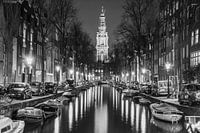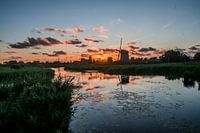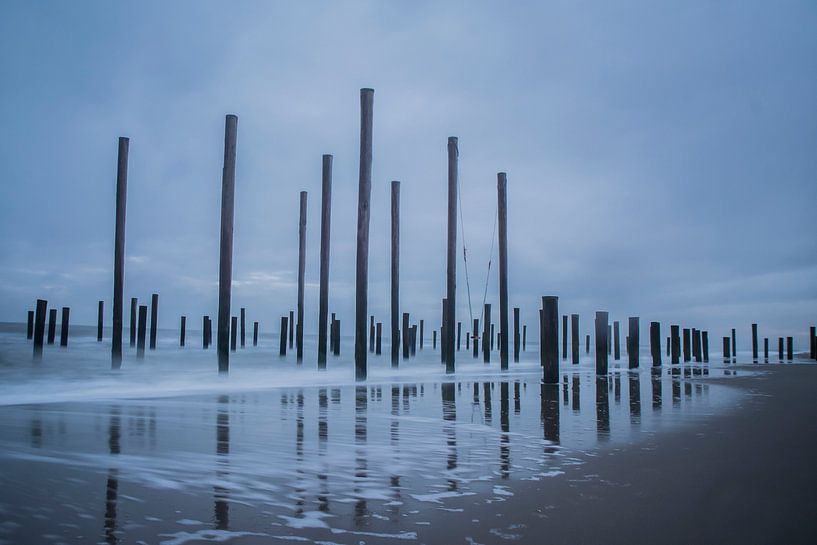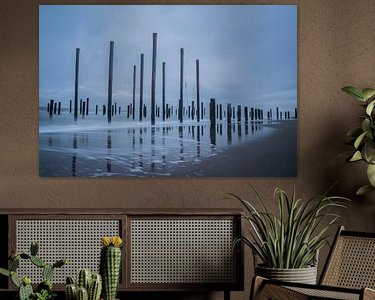Buy the photo Palm village with reflection by Stephan Scheffer on canvas, ArtFrame, poster and wallpaper, printed on demand in high quality.
About "Palm village with reflection"
by Stephan Scheffer
About the artwork
Petten is said to have originated in 739. The name refers to three wells that may have been located at the site. A sand dike between Petten and 't Oghe (Callantsoog) is mentioned as early as 1388. During the Sint-Elisabethflood (1421), Petten was completely swept away and the row of dunes was affected. In 1432, a weak dike was constructed behind the dunes and from 1506 onwards, active coastal defence took place, with pile heads made of beams from Norway and Sweden and stone from Vilvoorde. Still, more than 100 houses washed away in 1625. Petten's church stood about 20 metres from the beach and would last there until 1701. In 1793, the construction of the Hondsbossche Zeewering was started, and between 1870 and 1877, based on the idea of dike grave Cornelis van Foreest, the Zeewering with basalt slopes was built. Since then, the hinterland was dry and safe until new measures were needed in 2004. If you are in Petten aan Zee, you should definitely take a look at the Palendorp monument on the beach near Bergendstraat. This beautiful work of art consists of 160 poles six to 12 metres long. The poles are shaped like ten houses and a church. It is a reminder of old Petten, which was inundated by the sea long ago. A beautiful place to take photos during a sunset.

About Stephan Scheffer
I love to go out into nature and do landscapes and macro photography.
and also likes to follow Workshops to create unique footage,
I would also be very honoured if my work were to hang on the wall at your place to add a little more colour to your interior...
Read more…
 Netherlands
Netherlands Ordered in November 2016
Ordered in November 2016
 Germany
Germany Ordered in April 2023
Ordered in April 2023
 Netherlands
Netherlands Ordered in February 2021
Ordered in February 2021
 Netherlands
Netherlands Ordered in October 2021
Ordered in October 2021
 Germany
Germany Ordered in November 2020
Ordered in November 2020
 Germany
Germany Ordered in July 2019
Ordered in July 2019
 Germany
Germany Ordered in March 2019
Ordered in March 2019
 Germany
Germany Ordered in November 2020
Ordered in November 2020
 Germany
Germany Ordered in March 2021
Ordered in March 2021
 Netherlands
Netherlands Ordered in October 2019
Ordered in October 2019
 Netherlands
Netherlands Ordered in March 2023
Ordered in March 2023
 Germany
Germany Ordered in June 2020
Ordered in June 2020
About the material
Canvas
A classic and timeless material
- Fine-art print quality
- Frame made of sustainable wood
- Durability of minimum 10 years
- Available with floater frame
Discover the artworks of Stephan Scheffer
 Black and whiteStephan Scheffer
Black and whiteStephan Scheffer Long-eared owlStephan Scheffer
Long-eared owlStephan Scheffer Street in NewcastleStephan Scheffer
Street in NewcastleStephan Scheffer Tulips and MillStephan Scheffer
Tulips and MillStephan Scheffer European eagle owlStephan Scheffer
European eagle owlStephan Scheffer Steller's Osprey in flightStephan Scheffer
Steller's Osprey in flightStephan Scheffer Angry Red Kite.Stephan Scheffer
Angry Red Kite.Stephan Scheffer The West TowerStephan Scheffer
The West TowerStephan Scheffer A little tiredStephan Scheffer
A little tiredStephan Scheffer Sunset at the MolenkadeStephan Scheffer
Sunset at the MolenkadeStephan Scheffer Scottish HighlanderStephan Scheffer
Scottish HighlanderStephan Scheffer Female Scottish HighlanderStephan Scheffer
Female Scottish HighlanderStephan Scheffer Male Scottish HighlanderStephan Scheffer
Male Scottish HighlanderStephan Scheffer Close up Scottish HighlanderStephan Scheffer
Close up Scottish HighlanderStephan Scheffer Pink Blossom with a beeStephan Scheffer
Pink Blossom with a beeStephan Scheffer ( Cherry) BlossomStephan Scheffer
( Cherry) BlossomStephan Scheffer ( Cherry) Blossom in full bloomStephan Scheffer
( Cherry) Blossom in full bloomStephan Scheffer Look like an angelStephan Scheffer
Look like an angelStephan Scheffer Spoonbill with nesting materialStephan Scheffer
Spoonbill with nesting materialStephan Scheffer The endless path with colourStephan Scheffer
The endless path with colourStephan Scheffer













 Beach
Beach Clouds
Clouds Long Exposure Photography
Long Exposure Photography Mysterious Spheres
Mysterious Spheres Photo wallpaper
Photo wallpaper Photography
Photography Serene Peace
Serene Peace Water
Water









